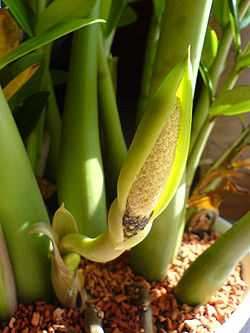Zamioculcas
| Zamioculcas zamiifolia | |
|---|---|
 | |
| A cultivated specimen | |
| Scientific classification | |
| Kingdom: | Plantae |
| (unranked): | Angiosperms |
| (unranked): | Monocots |
| Order: | Alismatales |
| Family: | Araceae |
| Subfamily: | Zamioculcadoideae |
| Genus: | Zamioculcas Schott |
| Species: | Z. zamiifolia |
| Binomial name | |
| Zamioculcas zamiifolia (Lodd.) Engl.[1] | |
Zamioculcas (Common name "Zanzibar Gem") is a genus of flowering plant in the family Araceae, containing the single species Zamioculcas zamiifolia. It is a tropical perennial plant native to eastern Africa, from Kenya south to northeastern South Africa. Dutch nurseries started wide-scale commercial propagation of the plant around 1996.[2]
Etymology
The botanical name derives from on the one hand the superficial similarity of its foliage to that of the cycad genus Zamia and on the other hand its kinship to the genus Colocasia under the alternative form 'Culcas'. Botanical synonyms include Caladium zamiaefolium, Zamioculcas loddigesii and Z. lanceolata. It is sometimes known by the trivial names "ZZ plant", "aroid palm", "fat boy", and "eternity plant".
History
It was first described as Caladium zamiifolium by Loddiges in 1829 (Bot. Cab. 15: t. 1408. 1829 ), moved to his new genus Zamioculcas by Heinrich Wilhelm Schott ( Syn. Aroid. 71. 1856) and given its established name Zamioculcas zamiifolia by Adolf Engler (Das Pflanzenreich 4, 23B: 305. 1905.)
Growth
It is a herbaceous plant growing to 45–60 cm tall, from a stout underground, succulent rhizome. It is normally evergreen, but becomes deciduous during drought, surviving drought due to the large potato-like rhizome that stores water until rainfall resumes. The leaves are pinnate, 40–60 cm long, with 6-8 pairs of leaflets 7–15 cm long; they are smooth, shiny, and dark green. The flowers are produced in a small bright yellow to brown or bronze spadix 5–7 cm long, partly hidden among the leaf bases; flowering is from mid summer to early autumn.
Toxicity
All parts of the plant are poisonous if ingested. A number of other sites claims that this is a myth.[3][4] It contains calcium oxalate. Needle-like calcium oxalate crystals could irritate different sensitive skin parts, mucosa, or conjunctiva.
Cultivation

Zamioculcas is grown as an ornamental plant, mainly for its attractive glossy foliage. It can be kept outdoors as long as the temperature does not fall below around 15 °C (59 °F); best growth is between 18 °C to 26 °C (65° to 79 °F). Hot temperatures give an increase of leaf production. In temperate regions, it is grown as a houseplant. Over-watering may destroy this plant; erring on the side of dryness is preferable to risking tuber rot. Do not use leaf shiners. A quarter or eighth strength liquid fertilizer such as fish emulsion or worm-cast liquid may be used once a month at the warmest period for potted specimens. Bright, indirect light is best for Zamioculcas, although it will tolerate very low light. Some sun will be tolerated, very early in the morning for hot districts – morning or afternoon for cooler districts.
Z. zamiifolia may be propagated by leaf cuttings: typically, the lower ends of detached leaves are inserted into a moist gritty compost and the pot enclosed in a polythene bag. Though the leaves may well decay, succulent bulb-like structures should form in the compost and these may be potted up to produce new plants. The process may take upwards of one year.
References
- ↑ "Zamioculcas zamiifolia information from NPGS/GRIN". www.ars-grin.gov. Retrieved 2008-03-24.
- ↑ Catherine, Horwood (2007). Potted History: The Story of Plants in the Home. Frances Lincoln Ltd. p. 173. ISBN 978-0-7112-2800-9.
- ↑ http://www.exoticrainforest.com/Calcium%20oxalate%20crystals.html
- ↑ http://www.exoticrainforest.com/Zamioculcas%20zamiifolia%20pc.html
External links
| Wikimedia Commons has media related to Zamioculcas. |
| Wikispecies has information related to: Zamioculcas |